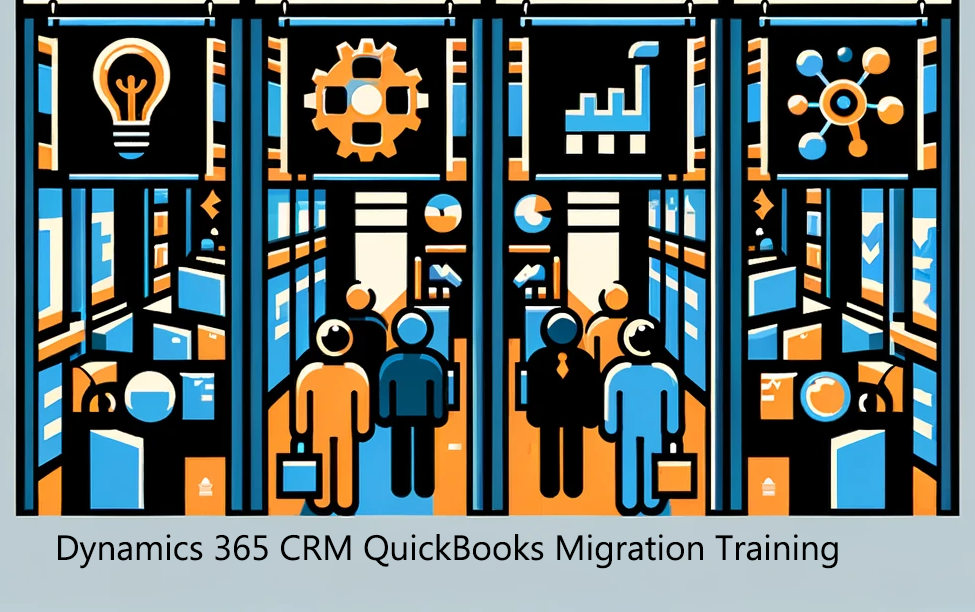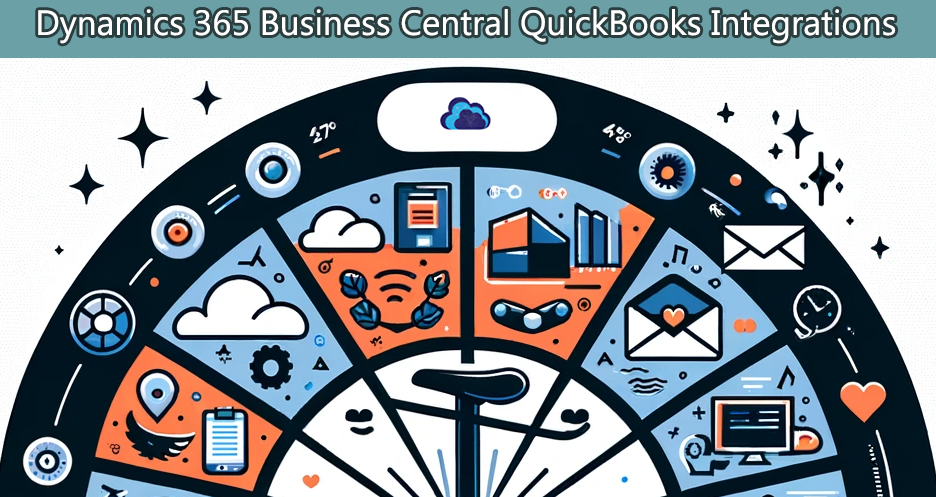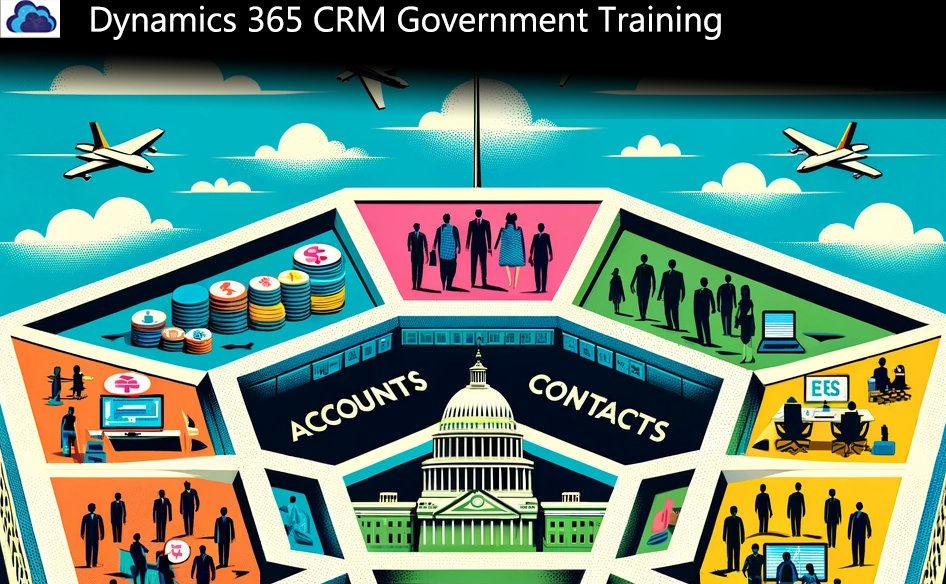In an age where digital transformation is not just a trend but a necessity, imagine the journey of a U.S. federal government agency from a cumbersome, archaic in-house financial system, which partly relies on QuickBooks, to the modern, cloud-based Dynamics 365 Business Central solution at Dynamics Edge.

The essence of QuickBooks, Dynamics 365 CRM components, Dataverse, Dynamics 365 Business Central, and the intricacies of migration and integration are particularly interesting when it comes to a U.S federal government agency!
QuickBooks, known for its straightforward approach to accounting with simple invoicing, expense tracking, payroll processing, and financial reporting, has been a staple in many small to medium-sized businesses and, in part, in the federal agency. However, its ease of use comes at a cost: limitations in scalability, depth of functionality, and vendor lock-in, particularly with its integrated payment gateway.

In contrast, Dynamics 365 Business Central is an all-encompassing enterprise resource planning (ERP) system. It extends beyond financial management to include supply chain, inventory, project management, and service order management. This shift marks a move from transactional management to comprehensive organizational orchestration.
At first glance, transitioning from QuickBooks to Dynamics 365 Business Central might appear daunting, even monumental. The intricacies of migrating large volumes of data, reconfiguring processes to fit a new system, and the potential for disruption in critical operations are considerable challenges. Without careful planning, such a migration risks data loss, system incompatibilities, and significant downtime.
Yet, the payoff for navigating this transition effectively is substantial. Dynamics 365 Business Central offers capabilities far beyond the scope of QuickBooks. It enables organizations to manage complex supply chains, streamline inventory management, optimize project management, and enhance overall service order management. These functionalities open doors to operations and efficiencies that were previously unattainable with the more limited QuickBooks system.
Power Platform adds another layer of capability to this migration. With tools like Power Automate Cloud Flows, Power Apps, and Power BI, the platform enables automation of workflows, development of custom applications tailored to specific organizational needs, and advanced data analytics that drive informed decision-making. This suite of tools can transform how a federal agency, or any organization, operates by enabling a level of customization and analysis that was not possible with the archaic system.
Power Platform’s integration capabilities are particularly transformative. They allow for seamless communication between Dynamics 365 Business Central and other systems, including Dynamics 365 CRM. This integration fosters a more unified, efficient operational framework, crucial for large organizations like a U.S. federal government agency.
Dynamics 365 CRM, now encompassing Sales, Customer Service, Project Service Automation, and Marketing, offers a range of functionalities.

Dynamics 365 for Sales revolutionizes how organizations manage their sales strategies and customer relationships. For an electronics retail manufacturer, for instance, this could mean better insights into customer behavior and more effective sales campaigns. For a federal government agency, it enhances the management of contracts and streamlines communication with vendors and stakeholders.
Customer Service in Dynamics 365 transforms the approach to customer interactions and support. It provides tools for omnichannel communication, allowing for a more cohesive and responsive customer service experience. This functionality is invaluable for any organization looking to improve its customer engagement and support services.
Project Service Automation in Dynamics 365 offers tools that are vital for efficient project management. It enables better resource allocation, project planning, and profitability tracking. For a federal agency, this means more transparency and accountability in managing government projects.
D365 Marketing, within Dynamics 365 integrates automation, campaign management, and customer insights, providing a comprehensive tool for crafting and executing effective marketing strategies. This is especially useful in a U.S. federal government agency, such as for public information campaigns or policy dissemination.

Learn with Dynamics Edge to leverage the transformative impact of migrating from QuickBooks to Dynamics 365 Business Central, augmented by the functionalities of Microsoft Dynamics 365 CRM and Microsoft Power Platform. It really represents a shift from basic transactional processes to a more integrated, efficient, and data-driven set of operational models. It’s a truly invigorating journey that not only enhances the capabilities of a United States federal government agency but also redefines its approach to managing complex organizational tasks, leading to more effective and responsive governance.
The transition from QuickBooks to Dynamics 365 Business Central is akin to transitioning from a cozy cottage to a smart home. What a shift it is to go from QuickBooks to Dynamics 365 Business Central! QuickBooks is like a quaint, familiar cottage – comfortable and sufficient for simpler times. It’s the ledger book on a shelf, reliable within its scope but limited in capability.

As a federal agency grows, so too does the complexity and breadth of its financial operations. The cottage, once sufficient, becomes restrictive, unable to accommodate the expanding needs and sophistication required in today’s fast-paced world.
Dynamics 365 Business Central represents the evolution to a smart home – modern, efficient, and equipped with the latest technology. It’s more than just an upgrade; it’s a transformative leap. This comprehensive platform extends beyond basic bookkeeping, offering a suite of tools adept at managing a wide array of tasks. From overseeing intricate supply chain logistics to handling nuanced project oversight and delving into advanced analytics, Business Central is the centralized command center that provides a panoramic view of the agency’s financial landscape.

This ERP solution transcends traditional number-crunching. It’s a strategic partner in the agency’s journey towards modernization. Dynamics 365 Business Central doesn’t just record financial transactions; it analyzes them, offering insights that were previously unseen. With this system, foresight becomes a tangible tool, enabling the agency to anticipate future challenges and opportunities. It’s about looking ahead, planning with precision, and making informed decisions that steer the agency towards its goals.
The implementation of Dynamics 365 Business Central is a significant undertaking, marking a new chapter in the agency’s operational narrative. This transition is about harnessing the power of data, transforming it into actionable intelligence. The platform’s robust analytics and reporting capabilities provide a clarity of vision that informs every aspect of the agency’s operations, from budgeting and procurement to compliance and risk management. It’s a strategic shift that elevates the agency’s ability to serve the public effectively.
The migration process is meticulous, requiring the careful mapping of data from one system to another. For government entities, this process is underlined by the need for heightened security and adherence to strict regulatory standards. Data must be transferred with confidentiality and integrity, ensuring that sensitive information is protected every step of the way. For non-governmental entities, the migration also poses challenges, but they revolve more around minimizing downtime and ensuring that the new system aligns with business processes to deliver immediate benefits.
Integration is a real important piece of the puzzle. It’s not just about moving data into a new home; it’s about making sure that it can communicate across the systems. Dynamics 365 CRM brings a level of interaction and customer engagement that QuickBooks couldn’t provide. This integration binds the operational processes with customer relationship management, knitting together sales, service, and marketing into a seamless garment that drapes over every aspect of the agency’s operations.
The federal agency’s migration from QuickBooks to Dynamics 365 Business Central, coupled with the integration of Dynamics 365 CRM, presents a complex scenario. This process involves transferring data, processes, and adapting operations from one system to another. For the agency, the migration carries additional layers of complexity due to the sheer scale, sensitivity of data, and regulatory requirements.
Within this grand transition, the agency is poised to achieve a level of operational synergy that was previously unattainable, positioning itself to serve the public with a newfound agility and insight. The path forward is clear, and while the journey is complex, the destination—a more capable, integrated, and efficient government—is well worth the effort.

Integration within the realm of digital transformation is so important, encompassing the creation of a seamless operational flow among diverse systems. This fluidity is achieved through the adept use of tools such as Power Automate Cloud Flows, Power Apps, and Power BI. Power Automate Cloud Flows excel in streamlining complex workflows, Power Apps in crafting tailored applications, and Power BI in distilling vast data into insightful analytics and reports.

The Dataverse platform stands at the heart of this integration, uniting disparate systems and ensuring the integrity and security of data. The approach of phased migration further streamlines the transition, offering a methodical rollout that mitigates risk and minimizes disruption. Throughout this process, the principles of ETL – extract, transform, and load – play an essential role in preparing data for a smooth transfer, ensuring each dataset is ready for its new digital residence within Business Central.
The transformation brought about by Dynamics 365 Business Central is most evident in the realm of capital asset management.

In the past, keeping tabs on such assets was a cumbersome process, fraught with manual checks and balances that often led to inaccuracies. Today, Business Central provides a suite of management features that not only track assets in real-time but also automate the calculation of depreciation, and proactively manage the lifecycle of each asset. This means that from acquisition to disposal, the system offers a clear, auditable trail that reflects the true value of the assets, ensuring that financial statements are accurate and up-to-date.
Operational expenses, key to any organization’s budget, have similarly undergone a revolutionary change. The old system’s reliance on spreadsheets or basic software often meant that categorization was a manual process, prone to errors and inconsistencies. Now, Business Central categorizes expenses with precision, assigning costs to the correct departments and projects without the need for constant human oversight. This level of automation and accuracy promotes fiscal responsibility and adherence to budgetary constraints, which is crucial for any government agency.

Contract services management, too, has been brought into the modern age. Where the old system might have struggled with tracking numerous contracts simultaneously, leading to a lapse in renewals or a failure to capitalize on favorable terms, Business Central provides an integrated contract management system. It alerts managers to key dates, tracks payments, and even assesses contract performance against deliverables. This comprehensive, effective solution ensures that the government agency can maintain robust vendor relationships and uphold contract compliance.
These advancements in purchase tracking are mirrored in the human resources department. Manual processes that once made recruitment, employee management, and retirement planning laborious are now seamlessly handled by Business Central. With this system, HR departments can access a centralized database that tracks each employee’s journey, automates benefits management, and assists in talent acquisition strategies.

The old system, which might have required multiple entries of the same data and offered little in the way of analytics, pales in comparison to the integrated, data-driven approach of Business Central.
Strategic sourcing and vendor management, once a domain of spreadsheets and fragmented databases, have been transformed by the procurement processes within Business Central. By leveraging real-time data, procurement teams can make informed decisions, negotiate better terms, and identify the best vendors for their needs. The old system’s reactive approach to sourcing is replaced with a proactive, strategic model that anticipates needs and manages vendor relationships effectively.

Budgeting and financial forecasting have similarly leaped forward. In the past, creating financial forecasts might have been based on historical data with little flexibility for changing conditions. Business Central, with its robust tools, offers predictive analytics and scenario planning. This means that financial teams can forecast with greater accuracy, modeling various outcomes to guide strategic decision-making.
Compliance reporting, an often cumbersome task, has been significantly simplified. The old system may have required manual compilation of data and reports, a time-consuming process with a high risk for error. Business Central automates this process, ensuring that the agency complies with regulations and standards with minimal effort. This automation not only saves time but also ensures a higher level of accuracy and reliability in compliance reporting, which is crucial for maintaining public trust and avoiding penalties.

In every aspect, the new system offers clear superiority over the old one. Where the old system was reactive, manual, and often siloed, Dynamics 365 Business Central is proactive, automated, and integrated. These qualities ensure that not only is the system more efficient, but it also provides the agency with the tools needed to make well-informed decisions, fostering a culture of transparency, accountability, and strategic foresight.
When looking at the old system, where such tasks were cumbersome and error-prone, highlights the benefits of the modern cloud solution. The old system’s shortcomings are starkly evident when placed side by side with the capabilities of Business Central. The former’s reliance on manual processes, its fragmented nature, and its limited reporting and analytics are all addressed by the comprehensive solutions offered by Dynamics 365.

Power BI’s integration with both Dataverse and Business Central facilitates a level of reporting and analysis that was unattainable in the past. Now, data flows freely, informing decisions and strategies with actionable insights that drive the agency forward. This integration is not merely a technological update; it is a transformative process that redefines the agency’s operational capabilities, setting a new standard for what is possible in government operations and beyond.
Additionally, other functions like human resources management, procurement, budgeting, and compliance reporting are significantly improved with Business Central, overcoming the limitations of QuickBooks and the in-house system.
The integration of Power BI with Dataverse and Dynamics 365 Business Central heralds a new era of business intelligence, particularly in the realm of lead management. In the old system, leads were often tracked through rudimentary methods, with QuickBooks and in-house solutions providing limited insight into potential customers’ behaviors and needs. Now, with Power BI’s sophisticated analytics, leads are not just numbers in a database. They are dynamic entities with rich profiles, enabling businesses to tailor their engagement strategies with precision. By leveraging data from Dynamics 365 CRM, organizations can anticipate needs, understand interests, and engage with potential clients in a far more strategic and personalized way.
Opportunities are the lifeblood of any sales operation, and the enhanced capabilities of Power BI transform how they are managed. In the past, opportunities might have been lost in the shuffle of day-to-day activities, their potential unrealized due to the lack of advanced tracking and analysis tools. Dynamics 365 Business Central changes the game, offering a detailed analysis of each opportunity, assessing its viability, and tracking its progress through the sales funnel. The integration with Power BI allows for a multidimensional view of sales pipelines, highlighting trends, and pinpointing areas for action, which was a significant shortcoming of QuickBooks and other outdated systems.

Contacts, the cornerstone of customer relationship management, are enriched through Power BI’s integration with Dynamics 365 CRM. Where once the details of contacts were trapped in static lists or spreadsheets, they are now part of a dynamic system that tracks interactions, preferences, and history. This shift means that every conversation, transaction, and touchpoint is recorded and analyzed, providing a comprehensive understanding of the customer journey. Such in-depth knowledge empowers businesses to build stronger relationships and offer targeted solutions, a stark improvement over the limited capabilities of archaic systems.
Accounts are managed with unprecedented clarity and control thanks to Power BI’s integration with Business Central and Dataverse. Accounting data, often a complex web of figures and reports, becomes a streamlined, accessible resource. Financial health indicators, performance metrics, and forecasting are all visualized intuitively, providing businesses with the information needed to make strategic financial decisions. This level of control and visibility is something that QuickBooks or in-house systems could not provide, often leaving businesses with more questions than answers regarding their financial standing.

As you can see, the combination of Dynamics 365 CRM, Business Central, and Dataverse, all brought together under the analytical prowess of Power BI, offers an experience that is light years ahead of what QuickBooks and traditional in-house systems could offer. Leads, opportunities, contacts, and accounts are not just data points; they are the gears in a well-oiled machine, driving businesses forward with intelligence and foresight. This powerful integration supports informed decision-making, fosters strategic planning, and ensures that businesses are well-positioned to respond to market dynamics effectively. The old ways of managing these elements seem antiquated in comparison, proving that modern solutions like Dynamics 365 and Power BI are not just improvements but necessary tools for any organization looking to thrive in today’s competitive landscape.
The journey of migration and integration for the federal agency, while complex, is a path toward more efficient, transparent, and responsive governance. It requires careful consideration of factors such as cybersecurity, data integrity, training, and change management to ensure success.
Reflecting on the agency’s transition, is emblematic of a broader movement within organizations to embrace digital solutions. The move from QuickBooks to Dynamics 365 Business Central, augmented by Dynamics 365 CRM and Power Platform, is not just an upgrade in software but a fundamental shift in operational philosophy. It symbolizes the transition from managing transactions to managing transformations, setting a new standard for efficiency, adaptability, and innovation in governmental operations.
Have a Question ?
Fill out this short form, one of our Experts will contact you soon.
Call Us Today For Your Free Consultation
Call Now